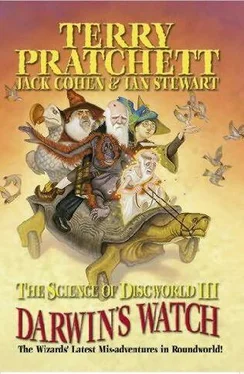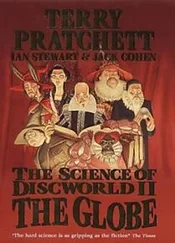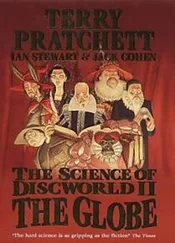Terry Pratchett - The Science of Discworld III - Darwin's Watch
Здесь есть возможность читать онлайн «Terry Pratchett - The Science of Discworld III - Darwin's Watch» весь текст электронной книги совершенно бесплатно (целиком полную версию без сокращений). В некоторых случаях можно слушать аудио, скачать через торрент в формате fb2 и присутствует краткое содержание. Жанр: Фантастика и фэнтези, на английском языке. Описание произведения, (предисловие) а так же отзывы посетителей доступны на портале библиотеки ЛибКат.
- Название:The Science of Discworld III - Darwin's Watch
- Автор:
- Жанр:
- Год:неизвестен
- ISBN:нет данных
- Рейтинг книги:3 / 5. Голосов: 1
-
Избранное:Добавить в избранное
- Отзывы:
-
Ваша оценка:
- 60
- 1
- 2
- 3
- 4
- 5
The Science of Discworld III - Darwin's Watch: краткое содержание, описание и аннотация
Предлагаем к чтению аннотацию, описание, краткое содержание или предисловие (зависит от того, что написал сам автор книги «The Science of Discworld III - Darwin's Watch»). Если вы не нашли необходимую информацию о книге — напишите в комментариях, мы постараемся отыскать её.
The Science of Discworld III - Darwin's Watch — читать онлайн бесплатно полную книгу (весь текст) целиком
Ниже представлен текст книги, разбитый по страницам. Система сохранения места последней прочитанной страницы, позволяет с удобством читать онлайн бесплатно книгу «The Science of Discworld III - Darwin's Watch», без необходимости каждый раз заново искать на чём Вы остановились. Поставьте закладку, и сможете в любой момент перейти на страницу, на которой закончили чтение.
Интервал:
Закладка:
Lewontin's discovery was a significant turning point in our understanding of heredity and evolution. It was at least as radical as the much better publicised revolution that replaced Newton's physics with Einstein's, and it was arguably more important. We will see that in the last year or so there has been another, even more radical, revision of our thinking about the control of cell biology and development by the genes. The whole dogma about DNA, messenger RNA, and proteins has been given a reality check, and science's internal `auditors' have rendered it as archaic as Fisher's population genetics.
It is commonly assumed - not only by the average television producer of pop science half-hours, but also by most popular science book authors - that now we know about DNA, the `secret of life', evolution and its mechanisms are an open book. Soon after the discovery of DNA's structure and mechanism of replication by James Watson and Francis Crick, in the late 1950s, the media - and biology textbooks at all levels - were beginning to refer to it as the `Blueprint for Life'. Many books, culminating with Dawkins's The Selfish Gene in the 1970s, promoted the view that by knowing about the mechanism of heredity, we had found the key to all of the important puzzles of biology and medicine, especially evolution.
There was soon to be a major tragedy, resulting from a medical application of that mistaken view. The sedative thalidomide was increasingly being prescribed, and bought over the counter, to treat nausea and other minor discomforts of the early weeks of pregnancy.
Only later was it discovered that in a small proportion of cases, thalidomide could cause a type of birth defect known as phocomelia, in which arms and legs are replaced by partially developed versions that resemble a seal's flippers.
It took a while for anyone to notice, partly because few general practitioners had experience of phocomelia before 1957. In fact, very few of them had ever seen a case at all, but after 1957 they began to see two or three in a year. A second reason was that it was very difficult to tie this defect to a particular potion or treatment: pregnant women famously take a great variety of dietary additives, and often they don't remember precisely what they've taken. Nevertheless, by 1961 some medical detective work had tied the spate of phocomelia down to thalidomide.
American doctors congratulated themselves on having missed out on the pathology, because Frances Kelsey, a medical worker for the Food and Drug Administration, had expressed misgivings about the original animal testing of the drug. Her misgivings eventually turned out to have been unfounded, but they did save much suffering in the USA. She noticed that the drug had not been tested on pregnant animals, because at that time such tests were not required. Everyone knew that the embryo has its own blueprint for development, quite separate from that of the mother. However, embryologists trained in biology departments, as distinct from medical embryologists, knew about the work of Cecil Stockard, Edward Conklin, and other embryologists of the 1920s. They had shown that many common chemicals could caused monstrous developmental defects. For instance, lithium salts easily induced cyclopia, a single central eye, in fish embryos. These alternative developmental paths, induced by chemical changes, have taught us a lot about the biological development of organisms, and how it is controlled.
They have also taught us that an organism's development is not rigidly determined by the DNA of its cells. Environmental insults can push the course of development along pathological paths. In addition, the genetics of organisms, particularly wild organisms, are usually organised so that `normal' development happens despite a variety of environmental insults, and even despite changes in some of the genes. This so-called `canalised' development is very important for evolutionary processes, because there are always temperature variations, chemical imbalances and assaults, parasitic bacteria and viruses; the growing organism must be `buffered' against these variations. It must have versatile developmental paths to ensure that the `same' well-adapted creature is produced, whatever the environment is doing. Within reasonable limits, at any rate.
There are many developmental tactics and strategies that help to accomplish this. They range from simple tricks like the HSP90 protein to the very clever mammalian trade-off.
HSP stands for `heat shock protein'. There are about 30 of these proteins, and they are produced in most cells in response to a sudden, not very severe, change of temperature. A different array of proteins is produced in response to other shocks; this one is called HSP90 because of where it sits in a much longer list of cell proteins. HSP90, like most HSPs, is a chaperonin: its job is to hug other proteins during their construction, so that when the long line of amino acids folds up it achieves the `right' shape. HSP90 is very good at making the `right' shape - even if the gene that specifies the chaperoned protein has accumulated a lot of mutations. So the resulting organism doesn't `notice' the mutations; the protein is `normal' and the organism looks and behaves just like its ancestral form.
However, if there's a heat shock or other emergency during development, HSP90 is diverted from its role as chaperonin, and other less powerful chaperonins permit the mutational differences to be expressed in most of the progeny. The effect this has on evolution is to keep the organisms much the same until there's an environmental stress, when suddenly, in one generation, lots of previously hidden, but hereditable, variation appears.
Most books that describe evolution seem to assume that every time there's a mutation, the environment promptly gets to judge it good or bad ... but one little trick, HSP90, which is present in most animals and many bacteria, makes nonsense of that assertion. And from Lewontin's discovery that a third of genes have common variants in wild populations, and that all organisms carry lots of them, it is clear that ancient mutations are continually being tested in different modern combinations, while the potential effects of more recent mutations are being cloaked by HSP90 and its ilk.
The trick employed by mammals is much more complex and farreaching. They reorganised their genes, and got rid of a lot of genetic complication that their amphibian ancestors relied on, by adopting a new and more controlled developmental strategy. Most frogs and fishes, whose eggs usually encounter great differences and changes of temperature during each embryology, ensure that the `same' larva, and then adult, results. Think of frog spawn in a frozen English pond, warming up to 35°C during the day while the delicate early development proceeds; then the little hatchling tadpoles have to endure these temperature changes. Now think of the frogs that so few of the tadpoles become.
Most chemical reactions, including many biochemical ones, happen at different rates if the temperature is different. You only get a frog if all the different developmental processes fit together effectively, and timing is crucial. So how does frog development work at all, given that the environment is changing so quickly and repeatedly?
The answer is that the frog genome `contains' many different contingency plans, for many different environmental scenarios. There are many different versions of each of the enzymes and other proteins that frog development requires. All of them are put into the egg while it is in mother frog's ovary. There are perhaps as many as ten versions of each, appropriate to different temperatures (fast enzymes for low temperatures, sluggish ones for higher temperatures, to keep the duration of development much the same) [49] That's very important for a few species. Zebra-fish eggs in the wild must hatch in just under 72 hours, because they're laid just before dawn and must hide before the third dawn when predators could see them.
, and they have `labels' on the packages that make them, so the embryo can choose which one to use according to its temperature. Animals whose development must be buffered in this way use a lot of their genetic programme to set up contingency plans for many other variables, in addition to temperature.
Интервал:
Закладка:
Похожие книги на «The Science of Discworld III - Darwin's Watch»
Представляем Вашему вниманию похожие книги на «The Science of Discworld III - Darwin's Watch» списком для выбора. Мы отобрали схожую по названию и смыслу литературу в надежде предоставить читателям больше вариантов отыскать новые, интересные, ещё непрочитанные произведения.
Обсуждение, отзывы о книге «The Science of Discworld III - Darwin's Watch» и просто собственные мнения читателей. Оставьте ваши комментарии, напишите, что Вы думаете о произведении, его смысле или главных героях. Укажите что конкретно понравилось, а что нет, и почему Вы так считаете.












